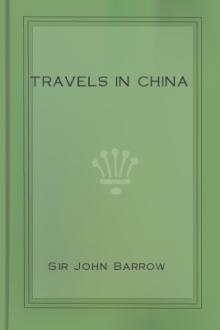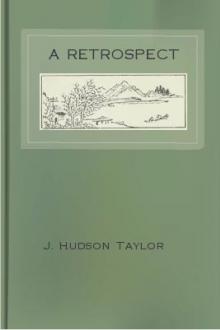Travels in China, Sir John Barrow [phonics readers txt] 📗

- Author: Sir John Barrow
- Performer: -
Book online «Travels in China, Sir John Barrow [phonics readers txt] 📗». Author Sir John Barrow
It is scarcely necessary to add any thing further with regard to the state of painting in China. I shall only observe, that the Emperor's favourite draughtsman, who may of course be supposed as good or better than others of the same profession in the capital, was sent to make drawings of some of the principal presents to carry to his master, then in Tartary, as elucidations of the descriptive catalogue. This man, after various unsuccessful attempts to design the elegant time-pieces of Vulliamy, supported by beautiful figures of white marble, supplicated my assistance in a matter which he represented as of the last importance to himself. It was in vain to assure him that I was no draughtsman; he was determined to have the proof of it; and he departed extremely well satisfied in obtaining a very mean performance with the pencil, to copy after or cover with his China ink. Every part of the machines, except the naked figures which supported the time-piece and a barometer, he drew with neatness and accuracy, but all his attempts to copy these were unsuccessful. Whether it was owing to any real difficulty that exists in the nice turns and proportions of the human figure, or that by being better acquainted with it we more readily perceive the defects in the imitation of it, or from the circumstance of the human form being concealed in this country in loose folding robes, that caused the Chinese draughtsman so completely to fail, I leave to the artists of our own country to determine: but the fact was as I state it; all his attempts to draw these figures were preposterous.
As to those specimens of beautiful flowers, birds, and insects, sometimes brought over to Europe, they are the work of artists at Canton where, from being in the habit of copying prints and drawings, carried thither for the purpose of being transferred to porcelain, or as articles of commerce, they have acquired a better taste than in the interior parts of the country. Great quantities of porcelain are sent from the potteries to Canton perfectly white, that the purchaser may have them painted to his own pattern: and specimens of these bear testimony that they are no mean copyists. It has been observed, however, that the subjects of natural history, painted by them, are frequently incorrect; that it is no unusual thing to meet with the flower of one plant set upon the stalk of another, and having the leaves of a third. This may formerly have been the case, from their following imperfect patterns, or from supposing they could improve nature; but having found that the representations of natural objects are in more request among foreigners, they pay a stricter attention to the subject that may be required; and we found them indeed such scrupulous copyists, as not only to draw the exact number of the petals, the stamina, and pistilla of a flower, but also the very number of leaves, with the thorns or spots on the foot-stalk that supported it. They will even count the number of scales on a fish, and mark them out in their representations, and it is impossible to imitate the brilliant colours of nature more closely. I brought home several drawings of plants, birds, and insects, that have been greatly admired for their accuracy and close colouring; but they want that effect which the proper application of light and shade never fails to produce. The coloured prints of Europe that are carried out to Canton are copied there with wonderful fidelity. But in doing this, they exercise no judgment of their own. Every defect and blemish, original or accidental, they are sure to copy, being mere servile imitators, and not in the least feeling the force or the beauty of any specimen of the arts that may come before them; for the same person who is one day employed in copying a beautiful European print, will sit down the next to a Chinese drawing replete with absurdity.
Whatever may be the progress of the arts in the port of Canton, they are not likely to experience much improvement in the interior parts of the country, or in the capital. It was the pride rather of the monarch, and of his ministers, that made them reject the proposal of Castaglione to establish a school for the arts, than the apprehension, as stated by the missionaries, that the rage for painting would become so general, as to be prejudicial to useful labour.
In a country where painting is at so low an ebb, it would be in vain to expect much execution from the chissel. Grotesque images of ideal beings, and monstrous distortions of nature, are sometimes seen upon the ballustrades of bridges, and in their temples, where the niches are filled with gigantic gods of baked clay, sometimes painted with gaudy colours, and sometimes plastered over with gold leaf, or covered with a coat of varnish. They are as little able to model as to draw the human figure with any degree of correctness. In the whole empire there is not a statue, a hewn pillar, or a column that deserves to be mentioned. Large four-sided blocks of stone or wood are frequently erected near the gates of cities, with inscriptions upon them, meant to perpetuate the memory of certain distinguished characters; but they are neither objects of grandeur nor ornament, having a much closer resemblance to a gallows than to triumphal arches, as the missionaries, for what reason I know not, have thought fit to call them.
The intention of these monumental erections will appear from some of their inscriptions.
Honour granted by the Emperor.
The grateful odour of one hundred years.
Retirement.Tranquillity.
Emperor's order.
Peace and Happiness,
The balm of Life.
On a fortunate day, in the 8th month of the 50th year of the
reign of Kien-Long, this monument was erected by the
Emperor's order, in honour of Liang-tien-pe, aged
102 years.
The two following are inscriptions on monuments that have been erected to chaste women, a description of ladies whom the Chinese consider to be rarely met with.
Honour granted by the Emperor.
Icy coldness.Hard frost.
The Emperor's order.
The sweet fragrance of piety and virginity.
Sublime chastity.Pure morals.
The whole of their architecture, indeed, is as unsightly as unsolid; without elegance or convenience of design, and without any settled proportion; mean in its appearance, and clumsy in the workmanship. Their pagodas of five, seven, and nine rounds, or roofs, are the most striking objects; but though they appear to be the imitations or, perhaps, more properly speaking, the models of a similar kind of pyramids found in India, they are neither so well designed, nor so well executed: they are, in fact, so very ill constructed that half of them, without any marks of antiquity, appear in ruins; of these useless and whimsical edifices His Majesty's garden at Kew exhibits a specimen, which is not inferior in any respect to the very best I have met with in China. The height of such structures, and the badness of the materials with which they are usually built, contradict the notion that they assign as a reason for the lowness of their houses, which is, that they may escape being thrown down by earthquakes. In fact, the tent stands confessed in all their dwellings, of which the curved roof and the wooden pillars (in imitation of the poles) forming a colonnade round the ill-built brick walls, clearly denote the origin; and from this original form they have never ventured to deviate. Their temples are mostly constructed upon the same plan, with the addition of a second, and sometimes a third roof, one above the other. The wooden pillars that constitute the colonnade are generally of larch fir, of no settled proportion between the length and the diameter, and they are invariably painted red and sometimes covered with a coat of varnish.
As custom and fashion are not the same in any two countries, it has been contended by many that there can be no such thing as true taste. The advocates for taste arising out of custom will say, that no solid reason can be offered why the pillar which supports the Doric capital should be two diameters shorter than that which sustains the Corinthian; and that it is the habit only of seeing them thus constructed that constitutes their propriety. Though the respective beauties of these particular columns may, in part, be felt from the habit of observing them always retaining a settled proportion, yet it must be allowed that, in the most perfect works of nature, there appears a certain harmony and agreement of one part with another, that without any settled proportion seldom fail to please. Few people will disagree in their ideas of a handsome tree, or an elegant flower, though there be no fixed proportion between the trunk and the branches, the flower and the foot-stalk. Proportion, therefore, alone, is not sufficient to constitute beauty. There must be no stiffness, no sudden breaking off from a straight line to a curve; but the changes should be easy, not visible in any particular part, but running imperceptibly through the whole. Utility has also been considered as one of the constituent parts of beauty. In the Chinese column, labouring under an enormous mass of roof, without either base or capital, there is neither symmetry of parts, nor ease, nor particular utility. Nor have the large ill-shapen and unnatural figures of lions, dragons, and serpents, grinning on the tops and corners of the roofs, any higher pretensions to good taste, to utility, or to beauty.
"The architecture of the Chinese," says one of their encomiasts, "though it bears no relation to that of Europe; though it has borrowed nothing from that of the Greeks, has a certain beauty peculiar to itself." It is indeed peculiar to itself, and the missionaries may be assured they are the only persons who will ever discover "real palaces in the mansions of the Emperor," or to whom, "their immensity, symmetry, and magnificence, will announce the grandeur of the master who inhabits them."
The house of a prince, or a great officer of state, in the capital, is not much distinguished from that of a tradesman, except by the greater space of ground on which it stands, and by being surrounded by a high wall. Our lodgings in Pekin were in a house of this description. The ground plot was four hundred by three hundred feet, and it was laid out into ten or twelve courts, some having two, some three, and others four, tent-shaped houses, standing on stone terraces raised about three feet above the court, which was paved with tiles. Galleries of communication, forming colonnades of red wooden pillars, were carried from each building and from one court to another, so that every part of the house might be visited without exposure to the sun or the rain. The number of wooden pillars of which the colonnades were formed was about 900. Most of the rooms were open to the rafters of the roof; but some had a slight ceiling of bamboo laths covered with plaster; and the ladies apartments consisted of two stories; the upper however had no light, and was not so good as our common attics. The floors were laid with bricks or clay. The windows had no glass; oiled paper, or silk gauze, or





Comments (0)